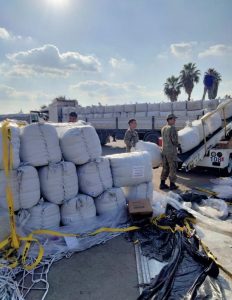
Air travel is typically regarded as an exciting experience that allows us to explore new cultures, taste exotic cuisines, and create memories that last a lifetime. However, amid the excitement, it’s crucial not to overlook another critical aspect of air travel: humanitarian and relief cargo flights.
In disaster relief operations, freighter charters emerge as a vital lifeline, offering unparalleled speed and flexibility in delivering essential supplies to afflicted regions. From earthquake-ravaged landscapes to regions devastated by medical emergencies, air cargo plays a pivotal role in swiftly transporting critical resources such as food, water, medical supplies, and shelter materials to those in need, particularly in areas where traditional transportation networks have been disrupted or destroyed.
In this article, we will delve deeper into how relief organizations can effectively achieve their mission of alleviating suffering and rebuilding lives in the aftermath of adversity by leveraging the speed, flexibility, and extensive reach of air transport.
The Challenges and Opportunities in Humanitarian Cargo Operations
Navigating the intricate landscape of humanitarian cargo operations entails confronting a number of challenges while simultaneously embracing opportunities for collaboration and innovation. While each situation is unique, below we outline some of the primary factors that are consistently faced in these operations.
Key challenges
- Addressing time-sensitive delivery requirements
In the chaotic aftermath of disasters, limited access to congested airspace can hinder timely delivery. Overcoming these obstacles requires meticulous planning, coordination, and the utilization of specialized air cargo services equipped to handle urgent and high-priority shipments.
- Overcoming infrastructure challenges in disaster-stricken areas
Natural disasters often inflict extensive damage on transportation infrastructure, including roads, bridges, and airports, impeding the flow of relief supplies. In remote or inaccessible regions, the lack of adequate infrastructure compounds logistical difficulties, necessitating innovative solutions for the delivery of aid.
Biggest opportunities
- Partnerships between governments, NGOs, and private sector entities
Effective humanitarian cargo operations rely on collaboration among various stakeholders, including governments, non-governmental organizations (NGOs), and private sector entities. By forging strategic partnerships, organizations can leverage their respective strengths and resources to enhance the efficiency and impact of relief efforts. Governments can provide logistical support and regulatory assistance, NGOs can offer expertise in humanitarian aid delivery, and private sector entities can contribute specialized assets and logistical capabilities.
- Streamlining coordination for effective cargo operations
Coordination and communication among stakeholders are essential for ensuring the smooth flow of relief supplies from donor countries to affected regions. Establishing clear lines of communication, standardized procedures, and information-sharing mechanisms can facilitate the rapid mobilization and distribution of aid.
Moreover, making use of the newest technology out there, such as logistics tracking systems and data analytics, can enhance situational awareness and enable real-time decision-making, thereby optimizing the allocation of resources and improving the overall effectiveness of relief cargo operations. We’ll come back to this topic later in the article to explore it further.
Case Studies of Successful Aid Air Cargo Missions

Within our, Chapman Freeborn’s, extensive experience, the following three case studies exemplify successful humanitarian air cargo missions, showcasing the diverse range of challenges faced and the consistent need for professionalism and focus across varied situations.
CASE #1: Oxygen zeolite transport for COVID-19 patients
- Transportation route: Southern Italy to India.
- Mode of transport: B747-400ERF freighter.
- Significance: Rapid and coordinated effort to transport zeolite, crucial for oxygen production, to address critical shortages during the COVID-19 pandemic.
CASE #2: Fire suppression helicopter deployment for wildfires
- Transportation route: Australia to Greece.
- Mode of transport: AN124s for helicopter transfer.
- Significance: Swift response to wildfires in Greece, requiring seamless coordination among multiple parties to deploy helicopters and support emergency response efforts.
CASE #3: Global aid response to earthquakes in Turkey
- Transportation route: Aid flights chartered to affected regions in Turkey from multiple countries including USA, UAE, Germany, Spain, Belgium, India, Saudi Arabia, Denmark, Singapore, and the Philippines.
- Mode of transport: various freighters, depending on specific client needs.
- Significance: International effort to provide humanitarian aid to Turkey following a devastating earthquake, overcoming logistical challenges and market volatility to deliver much-needed assistance to affected communities.
The Collaborative Nature of Relief Cargo Air Charters

The case studies presented above exemplify the intricate web of collaboration that underpins successful relief cargo air charters. In each scenario, diverse stakeholders, including humanitarian organizations, governments, and aviation industry players, came together to address urgent humanitarian needs with agility and efficiency. Key aspects of this collaborative approach in seeking more impactful responses include pooling:
- resources
- expertise
- networks
Technology also emerges as a critical enabler here, enhancing coordination throughout the many steps of the relief cargo air charter process. Utilizing advanced tracking systems, data analytics, and communication platforms, charter brokers involved can monitor shipments in real time, optimize routes, and respond promptly to evolving circumstances. This digital infrastructure fosters seamless communication and information-sharing, ensuring only informed decisions are being made.
In essence, the collaborative nature of relief cargo air charters underscores the importance of collective action in humanitarian response as a whole. By working together across sectors and turning to technology where possible, the impact of relief efforts can be maximized.
Conclusion
In times of crisis, the swift and efficient delivery of relief supplies can mean the difference between life and death for those affected by disaster Air cargo remains a go-to solution for such cases, offering unparalleled speed and flexibility in reaching remote or inaccessible regions where traditional transportation networks have been disrupted.
In light of this, we’d like to remind you that Chapman Freeborn stands ready to provide expert assistance and support regarding any emergency relief requests you may have. With a wealth of experience in organizing these types of operations and a global network of partners, our team of experts is equipped to handle every mission with professionalism and dedication.
If your organization requires prompt and efficient aid mobilization, Chapman Freeborn is always ready to assist. Contact us at [email protected], available round the clock, every day of the year, understanding emergencies can occur at any moment.